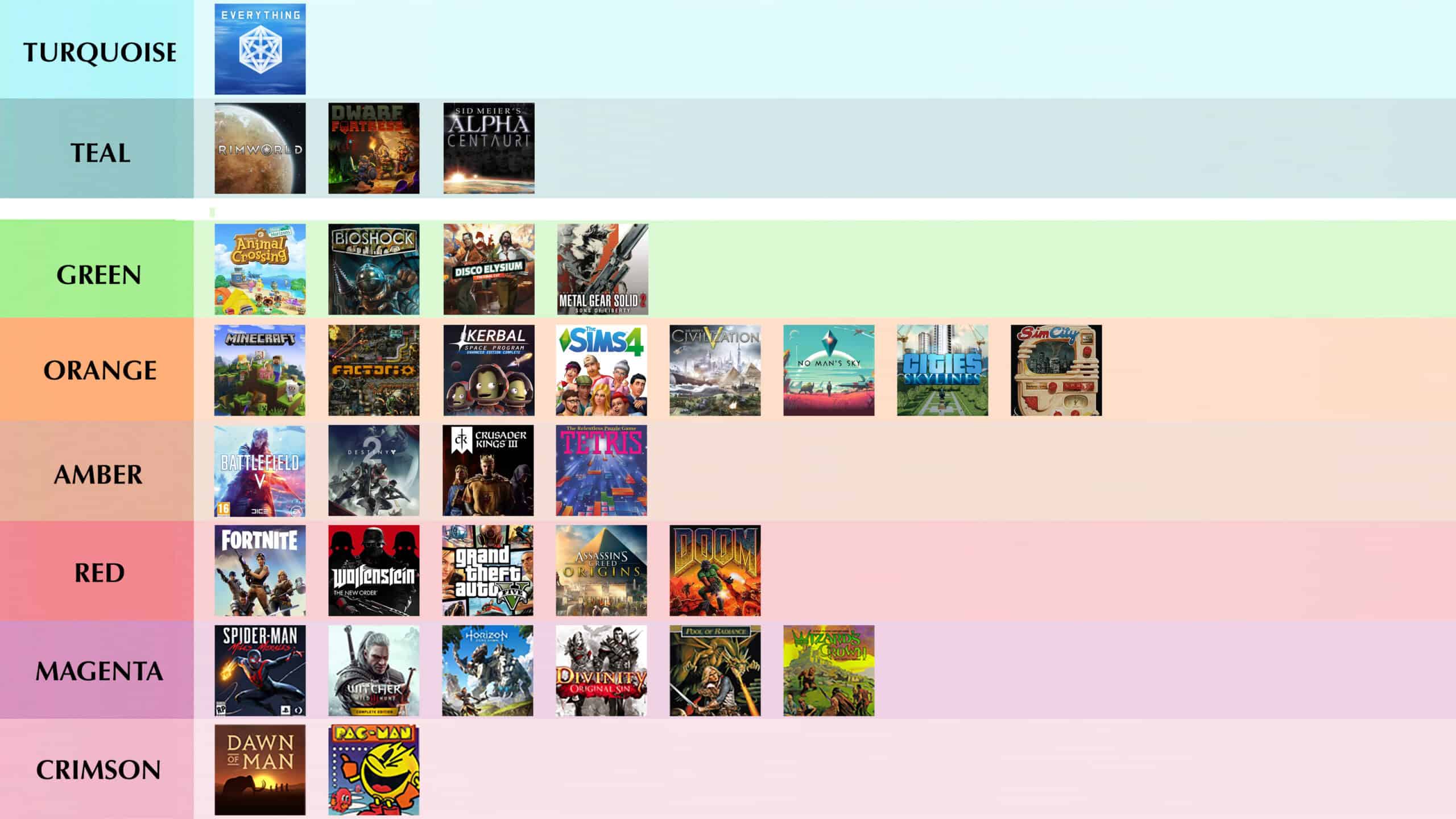Introduction
I
n this continuation of our “integral media” series, Ryan and Corey take another look at the major stages of human development, this time using a series of 33 video games in order to illustrate the qualities and characteristics of each stage.
All of this allows you to not only observe these stages within you, but to actively inhabit, engage, and play with them as well.
If you are already familiar with the mechanics of integral thought, this will be a great opportunity to practice applying the model to the world around us, deepening our appreciation of our world and the intricate strata of our cultural inheritance.
And if you don’t know very much about video games, this episode will introduce you to an entirely new genre of interactive media, as it features some of the very best and most popular games in history!
Considering just how prevalent video games have become in our culture, it’s surprising that it took us this long to do an episode like this! We hope you enjoy.
Crimson (archaic)
Cognitive: Sensorimotor • Worldview: Archaic • Values: Survival
The Crimson altitude (alternatively known as “infrared”, or “beige” in Spiral Dynamics) signifies a degree of development that is in many ways imbedded in nature, body, and the gross realm in general. Crimson altitude exhibits an archaic worldview, basic physiological needs (food, water, shelter, etc.), a self-sense that is minimally differentiated from its environment, and is in nearly all ways oriented towards physical survival. Although present in infants, Crimson is rarely seen in adults except in cases of famine, natural disasters, or other catastrophic events. Crimson is also used as a kind of catch-all term for many earlier evolutionary stages and drives.
The “survival” genre of video games typically features Crimson qualities. However, because most of these games tend to focus on content and themes from later stages, we decided not to include them in this segment. Instead, Corey deVos and Ryan Oelke use two other games to illustrate the Crimson stage — a neolithic city-builder called Dawn of Man, as well as the original game about food and survival: Pac-Man.
Magenta (magic)
Cognitive: Preoperational (symbolic) • Worldview: Magical • Values: Magic-animistic (“kin spirits”)
Magenta Altitude began about 50,000 years ago, and tends to be the home of egocentric drives, a magical worldview, and impulsiveness. It is expressed through magic/animism, kin-spirits, and such. Young children primarily operate with a magenta worldview. Magenta in any line of development is fundamental, or “square one” for any and all new tasks. Magenta emotions and cognition can be seen driving such cultural phenomena as superhero-themed comic books or movies.
Fantasy-based role-playing games and superhero-themed games often include qualities from the Magenta stage. Watch as Corey and Ryan take a look at some of these games, including Spider-Man: Miles Morales, The Witcher 3, Horizon: Zero Dawn, Divinity: Original Sin, Pools of Radiance, and Wizard’s Crown.
Red (egoic)
Cognitive: Preoperational (conceptual) • Worldview: Early mythic • Values: Egocentric (“power gods”)
The Red Altitude began about 10,000 years ago, and is the marker of egocentric drives based on power, where “might makes right,” where aggression rules, and where there is a limited capacity to take the role of an “other.” Red impulses are classically seen in grade school and early high school, where bullying, teasing, and the like are the norm. Red motivations can be seen culturally in Ultimate Fighting contests, which have no fixed rules (fixed rules come into being at the next Altitude, Amber), teenage rebellion and the movies that cater to it (The Fast and the Furious), gang dynamics (where the stronger rule the weaker), and the like.
First-person shooters are often associated with the Red stage, where the primary goal is to dominate anything and everything on the screen. Watch as Ryan and Corey look at several examples of Red video games, including Fortnite, Wolfenstein, the Grand Theft Auto series, Assassin’s Creed, and the game that kicked off the genre, Doom.
Amber (mythic)
Cognitive: Concrete Operational • Worldview: Mythic • Values: Absolutistic (“truth force”)
The Amber Altitude began about 5,000 years ago, and indicates a worldview that is traditionalist and mythic in nature—and mythic worldviews are almost always held as absolute (this stage of development is often called absolutistic). Instead of “might makes right,” amber ethics are more oriented to the group, but one that extends only to “my” group. Grade school and high school kids usually exhibit amber motivations to “fit in.” Amber ethics help to control the impulsiveness and narcissism of red. Culturally, amber worldviews can be seen in fundamentalism (my God is right no matter what); extreme patriotism (my country is right no matter what); and ethnocentrism (my people are right no matter what).
The Amber stage is often the home of team-based multiplayer games such as Battlefield 5 and Destiny 2, as well as some historic-based games such as the “feudalism simulator” Crusader Kings 3. The Amber stage is also associated with concrete-operational thinking, embodied by the classic game Tetris, as Ryan and Corey discuss here.
Orange (rational)
Cognitive: Formal Operational • Worldview: Rational • Values: Multiplistic (“strive drive”)
The Orange Altitude began about 500 years ago, during the period known as the European Enlightenment. In an orange worldview, the individual begins to move away from the amber conformity that reifies the views of one’s religion, nation, or tribe. The orange worldview often begins to emerge in late high school, college, or adulthood. Culturally, the orange worldview realizes that “truth is not delivered; it is discovered,” spurring the great advances of science and formal rationality. Orange ethics begin to embrace all people, “We hold these truths to be self-evident, that all men are created equal….” Ayn Rand’s Objectivism, the US Bill of Rights, and many of the laws written to protect individual freedom all flow from an orange worldview.
Strategy, simulation, and sandbox games are typically associated with the Orange stage of development, and often emphasize a “self-authoring” play style where the goals and win conditions are determined entirely by the player. Watch as Corey and Ryan discuss over a half dozen of these games, including Minecraft, Factorio, Kerbal Space Program, The Sims, SimCity, City Skylines, the Civilization series, and No Man’s Sky.
Green (pluralistic)
Cognitive: Early vision-logic (meta-systemic) • Worldview: Pluralistic • Values: Relativistic (“human bond”)
The Green Altitude began roughly 150 years ago, though it came into its fullest expression during the 1960’s. Green worldviews are marked by pluralism, or the ability to see that there are multiple ways of seeing reality. If orange sees universal truths (“All men are created equal”), green sees multiple universal truths—different universals for different cultures. Green ethics continue, and radically broaden, the movement to embrace all people. A green statement might read, “We hold these truths to be self-evident, that all people are created equal, regardless of race, gender, class….” Green ethics have given birth to the civil rights, feminist, and gay rights movements, as well as environmentalism.
The green worldview’s multiple perspectives give it room for greater compassion, idealism, and involvement, in its healthy form. Such qualities are seen by organizations such as the Sierra Club, Amnesty International, Union of Concerned Scientists, and Doctors Without Borders. In its unhealthy form green worldviews can lead to extreme relativism, where all beliefs are seen as relative and equally true, which can in turn lead to the nihilism, narcissism, irony, and meaninglessness exhibited by many of today’s intellectuals, academics, and trend-setters… not to mention another “lost” generation of students.
Interestingly, unlike most of the earlier stages, there do not seem to be any specific game genres that are strongly associated with the Green altitude. However, Green content and themes are very common in many of today’s games. Watch as Corey and Ryan discuss some of these games: Animal Crossing, BioShock, Disco Elysium, and what was perhaps the prototypical postmodern game, Metal Gear Solid 2.
Teal (integral)
Cognitive: Mid vision-logic (paradigmatic) • Worldview: Integral • Values: Systemic (“flex flow”)
The Teal Altitude marks the beginning of an integral worldview, where pluralism and relativism are transcended and included into a more systematic whole. The transition from green to teal is also known as the transition from “1st-tier” values to “2nd-tier” values, the most immediate difference being the fact that each “1st-tier” value thinks it is the only truly correct value, while “2nd-tier” values recognize the importance of all preceding stages of development. Thus, the teal worldview honors the insights of the green worldview, but places it into a larger context that allows for healthy hierarchies, and healthy value distinctions.
Perhaps most important, a teal worldview begins to see the process of development itself, acknowledging that each one of the previous stages (magenta through green) has an important role to play in the human experience. Teal consciousness sees that each of the previous stages reveals an important truth, and pulls them all together and integrates them without trying to change them to “be more like me,” and without resorting to extreme cultural relativism (“all are equal”). Teal worldviews do more than just see all points of view (that’s a green worldview)—it can see and honor them, but also critically evaluate them.
Teal games, at this point, are a bit hard to define, largely because it is still a newly emerging creative space. However, Corey and Ryan identify a couple qualities they look for at this stage — games that emphasize “emergent gameplay”, and games that consciously play with perspectives. Watch as we discuss some of the games that we enact and experience as Teal: Dwarf Fortress, Rimworld, and the classic Alpha Centauri.
Turquoise (mature integral)
Cognitive: Late vision-logic (cross-paradigmatic) • Worldview: Mature integral • Values: Systemic (“global view”)
Turquoise is a mature integral view, one that sees not only healthy hierarchy but also the various quadrants of human knowledge, expression, and inquiry (at the minimum: I, we, and it). While teal worldviews tend to be secular, turquoise is the first to begin to integrate Spirit as a living force in the world (manifested through any or all of the 3 Faces of God: “I”—the “No self” or “witness” of Buddhism; “we/thou”—the “great other” of Christianity, Judaism, Hindusm, Islam, etc.; or “it”—the “Web of Life” seen in Taoism, Pantheism, etc.).
Turquoise games are almost impossible to find. But we did find one that we think would qualify — an experimental game appropriately titled Everything. Featuring multiple pointing-out instructions by Alan Watts, Everything is a deeply meditative game where perspective-taking is itself the central gameplay mechanic. The game allows you to inhabit the 1st-person perspective of just about everything in the universe, from subatomic particles to subtle spiritual archetypes, producing all sorts of interesting reflections and state experiences for the player.
EMERGE — HOW TO THRIVE IN A WORLD GONE MAD
These chaotic times bring us in touch with what matters most, whispers of death and rebirth, as our global life conditions passionately usher us toward all of what could be, of what wants to emerge in your life.
Emerge is a new training program by Ryan Oelke, offering a thoughtful 3-phase process that will empower you to fully inhabit your experience, more deeply relate in real-time to life, and to formulate agile paths of response and action. With this embodied integral training, you will both be more passionately inspired from the core of your being and you will more successfully see the change, experiences, and results you and we long for and need in this moment and in the future.
Learn how Emerge can help you find traction for your transformation






